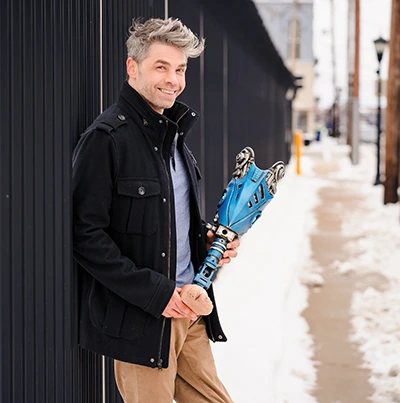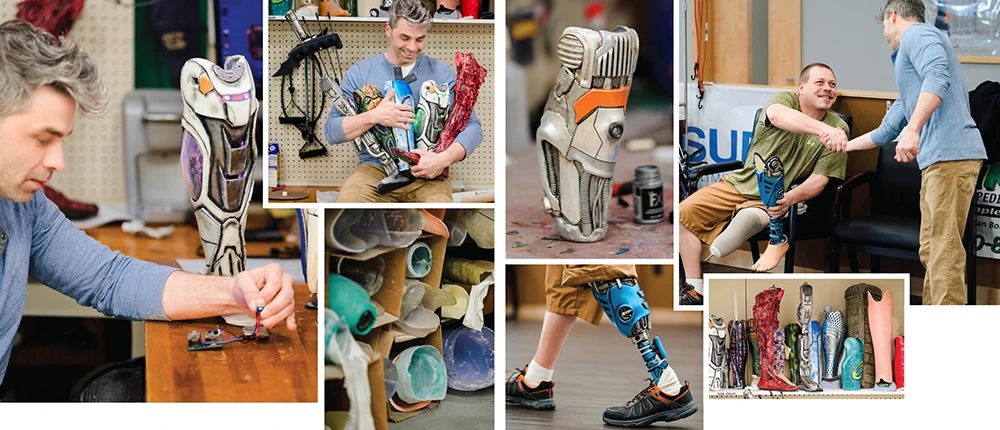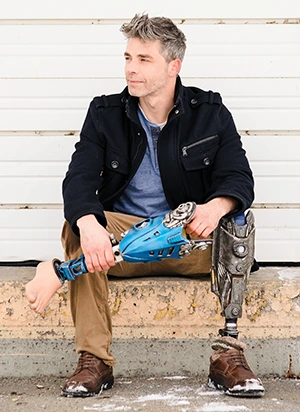Nick Harrier builds artistic, custom-built leg covers that change amputees’ lives—and he gives them away for free.
by Rene Agredano

Nick Harrier began hacking his own prosthetic covers because he had “a desire not to look like a catalog.” Instead of ordering a flashy (and expensive) design from an online vendor, Harrier salvaged some leftover construction materials and carved, glued, and sculpted the scraps into a one-of-a-kind, cyberpunk-themed work of art.
It didn’t just look cool. It also captured a piece of Harrier’s identity—which, in turn, sparked much healthier responses than the awkward glances and tentative conversations he encountered after limb loss.
“That was one of the more unexpected aspects of wearing it,” Harrier says. “When I got out in public, it completely shifted the conversations I was having. Before that, people would be curious [about my limb loss], but they were worried about being disrespectful. You could hear it in their voice. They were hesitant or apprehensive.” When they finally worked up the nerve to ask what happened, Harrier would oblige them with a well-rehearsed tale. “Everybody’s got a story that they’ve told 100 times, right?” he laughs. “You get really good at telling it.”
But once he started wearing his distinctive cover in public, people no longer inquired about Harrier’s missing leg. They wanted to know about his leg art. It was something they could relate to, an invitation to connect. Instead of awkwardly inquiring about an unfamiliar point of difference, they could bond with Harrier over a shared enthusiasm for the imagery of H.R. Giger or the films of Ridley Scott.
“It changed my experiences out in the world,” he explains. “I felt like it was too good to keep to myself. Other people needed to feel what this feels like. They need to feel in love with their legs again.”
So Harrier started custom-building covers for fellow amputees who couldn’t find what they wanted in the commercial marketplace. Some discovered his talents via Oakland Orthopedic Appliances in Bay City, Michigan, where Harrier works as a prosthetic technician. Others see his work on social media. He’s shipped covers all over the country and even overseas. And perhaps most surprising of all, Harrier donates his wearable art to the person who requested it, completely free of charge.

“There is nobody currently in the field of prosthetics that is making the things he creates,” says Oakland Orthopedic’s owner, Corey Smith, a second-generation prosthetist who’s spent a lifetime in the industry. Wildly unconventional and handmade with a broad range of motifs, Harrier’s works are the result of deep collaboration between artist and patron. They’re as personalized as a custom tattoo, featuring whatever mind-blowing concepts Harrier and his customer can imagine. Yet even the most out-there covers tend to have a normalizing effect, opening the door to conversations about limb loss that are neither awkward nor embarrassing.
A prosthetic cover might seem an unlikely canvas for artistic expression. But Harrier’s covers tend to produce the kind of transformative effect we usually associate with great art: They forge emotional connections and provide an outlet for complex feelings that might feel too risky to explore via other means.
Just Three Words
Harrier didn’t grow up with creative ambitions. He operated a Braille transcription business until cancer and a subsequent infection cost him his left leg at age 28. When Harrier became a patient at Oakland Orthopedic he instantly felt at home, finding the kind of support team that felt like a second family. As he grew more familiar with prosthetic technology, he started sharing ideas to improve the feel, look, and functionality of his devices. The positive response from Oakland’s staff piqued Harrier’s interest in the profession; he became a certified prosthetic technician and joined the company in 2015. And when his artistic ability began to emerge, his bosses at Oakland encouraged him to cultivate those talents.
Smith is a particularly big supporter. In his decades of experience, he has learned the value of a prosthesis that fits well in every sense—physically, aesthetically, and emotionally. “I think that’s something that for many, many years in our industry was overlooked,” he says. “The fit of it is always going to be the priority, but there is a whole body-image and self-awareness piece to that, which I think is just as important.”
Oakland clients who request a custom cover meet separately with Harrier after their regular appointment. They bounce ideas around to shape their vision of the cover design. Eventually, Harrier prompts them to narrow everything down to just three words.
“The best method that works for trying to get the aesthetic of what someone else has in mind is if they could just give me three adjectives that let me kind of see it,” he says. “Once you start putting it together like a puzzle, it really only goes together one way. It just makes itself. I don’t know how else to describe it. I imagine it’s a lot like how a songwriter just writes a song. It just happens.”
With that trio of adjectives continuously looping in his mind, Harrier embarks on his creative journey. By day, he fulfills his regular duties at Oakland as prosthetic technician and social media manager. After hours, often late into the night, he works on his craft in the clinic’s spacious fabrication lab. Some covers only take a few days to finish. Others take several weeks because of his workload, or because of the complexities and demands of a given project. The process to completion can feel agonizingly slow to Harrier, but the wait always seems worth it when he presents the end result to the user.
“When it’s done, there’s nothing like it,” raves Smith. “The responses are remarkable. Patients are so proud about the device they are wearing and how it makes them feel. I think that a good descriptor would be ‘profound.’ There are tears. There are so many visits where they are just kind of in awe, like: ‘That’s exactly what I imagined it would be!’”
There’s Research Behind the Results
Regaining confidence in one’s body image is one of the most difficult aspects of limb loss, but custom prosthetic covers of any kind can shorten the timeline to get there. According to an August 2022 study conducted by researchers at the Department of Physical Therapy at the University of Nevada, Las Vegas, “Almost 70 percent of the surveyed prosthetists reported that they noticed more positive attitude, improved motivation, compliance, and function in patients who owned a prosthesis with customized cosmetic design options.” Patients are more satisfied with the look of their prosthesis when they can provide direct input in designing it, and they report higher levels of empowerment than people who don’t have a say in how their prosthesis looks.

“It’s all interconnected,” says clinical psychologist Suzi Phelps. “Mind and body are completely intertwined, so if you’re feeling good and proud, and your head is held high about something, then that certainly affects your body and your posture.”
An amputee since 1996, Phelps fully understands the important role a personalized cover can play. Like a piece of jewelry, a tattoo, or a specialized item of clothing, a prosthetic cover lets users make a statement about who they are and what they care about. “It creates a positive conversation starter,” she says. “Somebody doesn’t immediately see you and go, ‘Oh my gosh, this horrible thing happened to you! What happened?’” Instead, Phelps observes, “People see it and go, ‘What an incredible piece of art!’ To take something that’s a negative and make it a positive is a really cool thing.”
Jay Mitchell formed an immediate bond with Harrier when the two met at Oakland Orthopedic. “He was relatable right off the bat, just because he is in the same position as me,” says Mitchell, who lost his leg above the knee in 2019 as a complication of diabetes. A 50-year-old musician and tattoo artist, he shares Harrier’s passion for crafting body art. He also has a discerning eye, so he recognized Harrier’s talent for visual imagery right away. “I had seen all the stuff Nick had done,” he says. “Corey [Smith] showed me some pictures, but it was completely different seeing the stuff in person. I was just blown away.”
After being fitted for his high-tech bionic leg, Mitchell approached Harrier and asked if they could collaborate on a custom cover. It took some time to settle on a concept that reflected Mitchell’s large, colorful personality. They eventually settled on a mechanical cyborg design, which felt like a natural choice. “I figured if it was gonna be a robotic leg, I might as well have a half-man, half-machine type of thing,” Mitchell laughs. “Even before I was done describing everything, you could see the wheels turning in his head. You could see it in his eyes.”
The result exceeded Mitchell’s wildest dreams. The rugged-looking armor, glowing in a sea of deep-green metallic hues, reflects his lifelong passion for comics, video games, and tattoos. It’s especially fun to wear during summer, when it’s shorts season in Michigan and people can actually see it. The fact that it was created just for him, by a fellow artist who understands what it’s like to be an amputee, carries special value for Mitchell. “Being expressive is very important to me,” he says. “It’s a big characteristic of who I am. I think that’s important for anyone, having a leg that you can help design.”
Not About the Benjamins
For Michael Lawrence, who lost his leg below the knee to a gunshot wound more than 20 years ago, the prospect of a free, custom-made prosthetic cover seemed too good to be true. Lawrence pays frequent visits to Oakland Orthopedic, because his physically strenuous job at a sugar processing plant causes ongoing weight shifts that, in turn, require routine prosthetic adjustments. Oakland’s attentive service fits his needs perfectly. The chance to work with Harrier came as an unexpected bonus.
“Halloween was coming up, so I said, ‘Make me a Halloween leg,’” Lawrence recalls. A few weeks later, Harrier presented him with a creepy, bloody, degloved limb that would make Wes Craven jealous. Stunned by the realistic gore, Lawrence said: “Man, that is a movie prop. That is really good!”
Harrier has since made other covers for Lawrence, and people stop him on the street to talk about his leg. It doesn’t matter if he’s wearing the illustrated King of the Jungle cover (featuring a lion pride that beautifully represents Lawrence’s family), his rugged robotic cover with LED lights, or the gory leg that’s still a big hit at Halloween parties. Each turns the tables on how strangers interact with Lawrence, making it easier than ever to overcome the amputation conversation hurdle. “I like people looking at it and being like, ‘Hey, dang, that’s nice! Hey, who did that?’” he says.
People from around the world have discovered Harrier’s art through his Instagram profile, allowing him to diversify both geographically and stylistically. He’s shipped covers as far away as Norway and the Netherlands, explored motifs that range from steampunk to pearlescent, and worked for regular Janes, high-profile influencers, and everyone in between. There’s only one constant: Harrier won’t accept any payment.
“I will never charge,” he says flatly. “I have thought about this, and the only way I’m willing to do it is if people get it for free.”
Even if he had enough customers to make a full-time living as the Salvador Dali of prosthetic covers—and that day may already have arrived—Harrier knows how many extra costs amputees have to absorb, and he refuses to add to the burden. If he could find the financing to establish a 501(c)(3) or partner with an existing nonprofit, that might allow him to devote more time to his avocation and serve more amputees. He’s also willing to train people to do what he does, as long as they, too, will donate their work.
“I’m not trying to be the only one who does this,” he says. “I will teach what I know for free. At the end of the day, it isn’t a bottom-line thing. I really am just trying to spread this around. I just want it out there.”




